Crafting Engaging Cold Emails in 5 Steps

There was a time when mass marketing used to work but it doesn't anymore. The rules have changed. Personalized cold emails tend to perform better than their counterparts. Personalized emails improve CTR by 14% and conversion rate by 10%. Advanced personalized emails with custom snippets have 17% reply rate as compared to their counterparts that have a mere 7% reply rate.
So cold emails aren't always ignored as long as they're well-thought and personalized. The 5-ingredient recipe for crafting successful personalized cold emails will help your sales team see a decent reply rate.
Here is an overview of the 5-ingredient recipe:
Ingredient #1: Collect relevant data
Ingredient #2: Create a unique template
Ingredient #3: Understand your individual prospect
Ingredient #4: Create a 'hook'
Ingredient #5: Smart follow up
Ingredient #1: Collect relevant data
It is a core ingredient, use it carefully. You don't just need data on your prospects but you need relevant data. Personalization relies on the data you collect and if it is irrelevant, your email won't remain personalized anymore. For instance, if you happen to refer to your prospect 'position' in their organization (CEO, CMO, designer, etc.) in your email. You have to ensure that you're referring to the prospect's current position. Referring to an old position or a wrong position means nothing but disaster.
So how you collect relevant data on your prospects? It is a 2-step process:
1. Primary data collection
2. Core data collection
1. Primary data collection
Primary data involves basic data collection such as:
- Full name
- Email address
- Company
- Designation
- Phone number
- Location
- Social accounts
- Website
- Personal blog/website
It calls for a serious research - that's done manually. You'd need a virtual assistant to help you with market research to create a database of relevant prospects. The primary information can be accessed online from the website, social accounts, and WHOIS information. There are some powerful outreach tools out there that can be really helpful in collecting primary data on your prospects.
Let's assume, your prospects are founders of project management tools. A quick research on Google will reveal hundreds of project management tools.
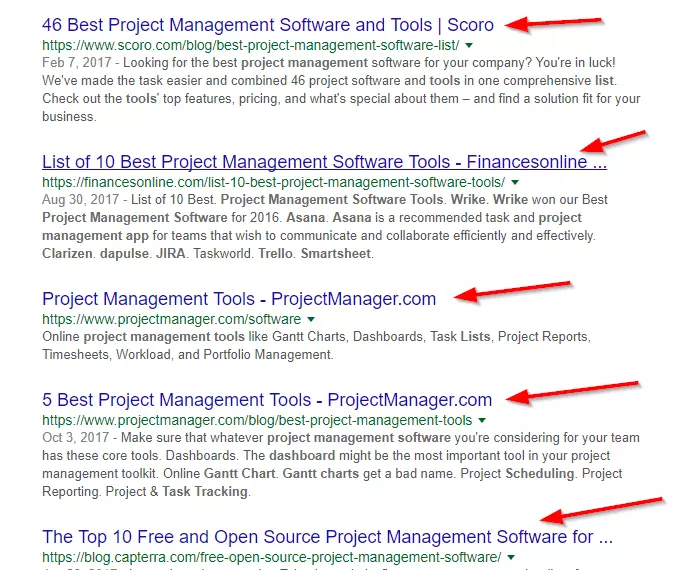
Prepare an Excel sheet, add all the tools, and add their founders' names with relevant information.
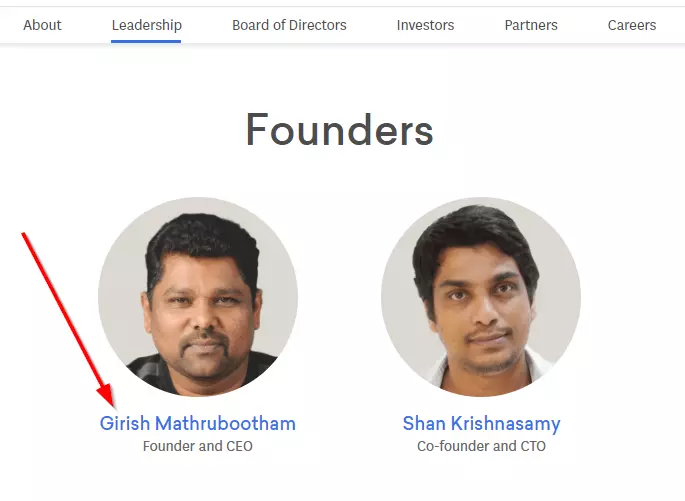
Here is Freshdesk's Mathrubootham LinkedIn account that's available on Freshdesk website.

You get the idea.
2. Core data collection
Primary data doesn't provide you much information about your prospect and is, therefore, least helpful in crafting a personalized email. While most of the sales reps stop at primary data and proceed with the email, you don't have to do it. Go a step ahead.
Core data helps you get closer and connect deeper with your prospects - individually.
It focuses on data collection that includes:
- Recent tweets, LinkedIn posts, and social media activity.
- The most recent post they have written, commented on, or have talked about on any social network.
- Job challenges.
- Interests and hobbies beyond current position.
- Awards, recognition, press coverage, etc.
- Peers, relatives, friends, and family.
And so on.
Go as deep as you can and try to find as many connection points as possible. Core data helps you build rapport and craft a personalized email that refers to one or more connection points that persuade your prospects to respond.
Ingredient #2: Create a unique template
Create several personalized unique templates. Each template should target one core variable identified above.
Here is a cold email template you can use to contact prospects who have published a recent post that's relevant to your offer:
Hi [Name],
I read your post on [post title] and I must say it is impressive. I loved it.
I'd like to tell that our product solves this very issue that you talked about in your several posts and tweets: [here], [here], and [here].
Our product helps users in several ways [mention a couple benefits]. You can read case studies and testimonials [here], [here], and [here].
A reply to this email will qualify you for a 20% discount. [Clearly state your offer here]
Regards,
[Name]
You can create several templates for every variable that you identified. You can even use multiple variables in a single email to take personalization to a new level.
And don't forget about your subject line! Personalizing your subject line with the recipient's name or company name can boost open rates by up to 50%.
Ingredient #3: Understand your individual prospect
Cold emails generally target a segment or a buyer persona. This is one reason why cold emails don't do well. A clear understanding of every individual prospect and tweaking the template makes your email personalized in the true sense.
You'll still use a template but it has to be tweaked based on variables identified. Here is the deal: You cannot find exact same details about every prospect. Some of them won't have a phone number, others won't have a personal blog, some of them won't be on Facebook, few of them will share a common pain point, and so on.
This calls for understanding individual prospects at the deepest level possible and using the most appropriate variable in the email. Keep the number of prospects per email template as low as possible. It will improve reply rate. Research shows that as the number of prospects increases, reply rate decreases.
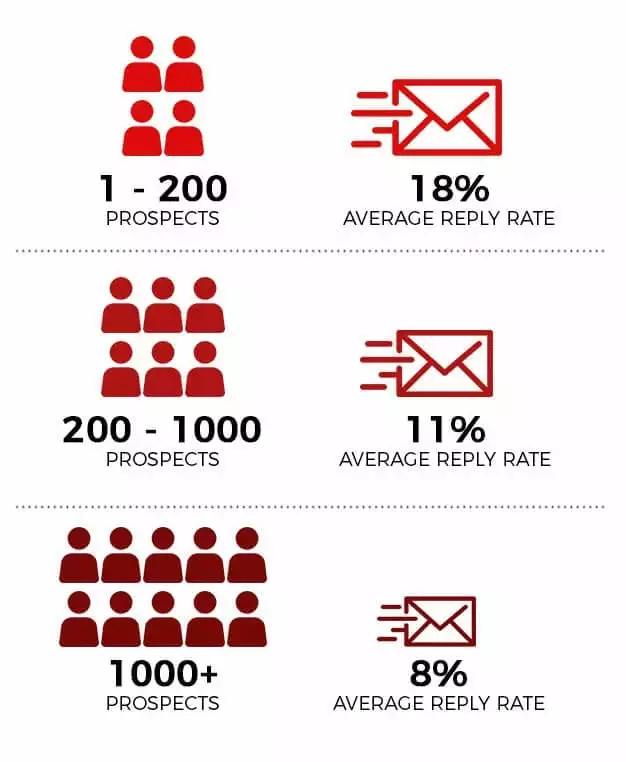
Keep your number of prospects for every template as low as you can. The minimum number is one per email, and that's where you can achieve highest reply rate. Here is a cold email that Bryan received from Siggy.
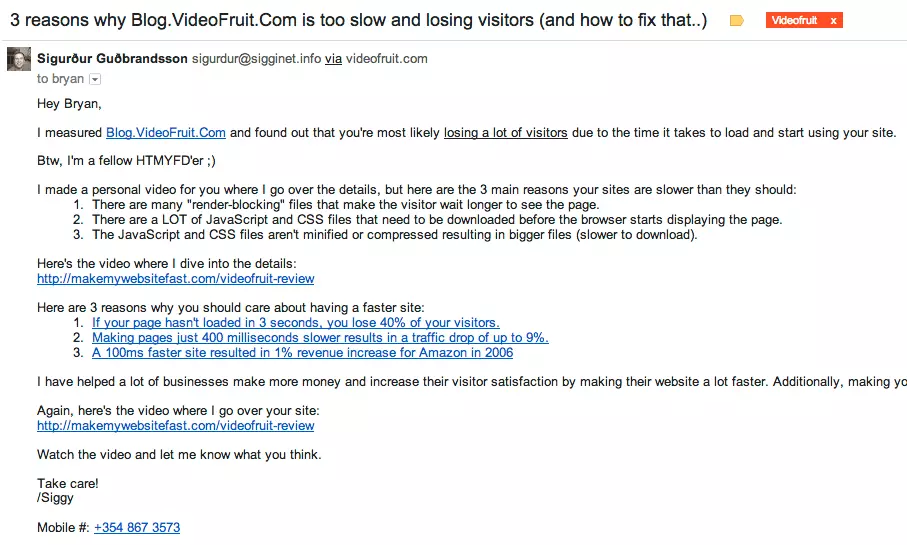
Siggy created a 5-minute video for Bryan to show him issues with his site's speed and how to improve load time. This is how you create a personalized email that your prospect cannot reject. Bryan says: "Guess how long it took me to hire him? 5 seconds!" This type of individual emails are best but there are times when you don't have the resources to go this deep.
Ingredient #4: Create a 'hook'
The hook is the main ingredient in your recipe.
A hook is a short phrase or a sentence used to entice prospects by arousing their interest in your product/email. A hook is a major predictor whether an email that's opened and read will be replied to or deleted. There has to be one heck of a powerful hook in your email, else you'll see a decent open rate with a fairly poor reply rate.
The 3-ingredients above are, by their very nature, powerful hooks, but you have to create at least one special hook for each template. Your hook should be driven by a pain point. Create multiple hooks for every pain point. Don't use two hooks in a single email. One hook is fine.
Here is a hypothetical example of a perfect hook that is based on Star-Chain-Hook technique.
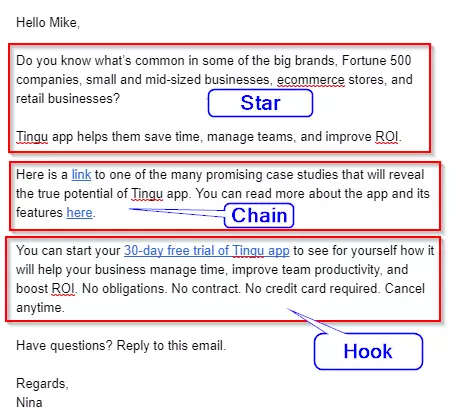
See how clearly this email describes what it is for and what's in it for the reader.
Ingredient #5: Smart follow up
Never send a single cold email. It has to be a sequence. The rule is simple: As the number of emails in the sequence increases, the reply rate increases exponentially. For an email sequence having 1-3 emails, the average reply rate stands at 9% but for a sequence with 4-7 emails, the reply rate jumps to 27%. If your first email isn't answered, you have 21% chance of getting a reply to the second email. A single cold email isn't worth it, especially when you have spent several resources on it. Don't go without a follow-up.
The follow-up has to be smart - not just another template or a soft reminder. Use a new hook in the follow-up. Here is an example.
Hi [Name],
I already contacted you on [date] regarding [use a powerful reference point to your previous email].
We have published a new case study on how our product helped [client A] with [results]. Here is a link.
Should you be interested in seeing similar results?
Regards,
[Name]
Here is another example.
Hi [Name],
I already sent you an email on [date].
I just saw your recent (social) post [post title] on [post's challenge]. Our product solves the [mention the issue].
What's the best time to talk?
Regards,
[Name]
There are several ways to make your follow up catchy so it isn't ignored.
Manage your emails and follow ups with Mailbird.
*BONUS* Secret chef tips
The following 4 secret chef tips will help you take cold email personalization to a new level.
Learn the art of empathizing
Put yourself in your prospects' shoes. Focus on your prospect needs and tell him how your company will help him get rid of the challenge he is facing. This email by Mohit Garg had a 33% reply rate. See how perfectly they have empathized with the prospect by mentioning brands that had a common link with the prospect's company.
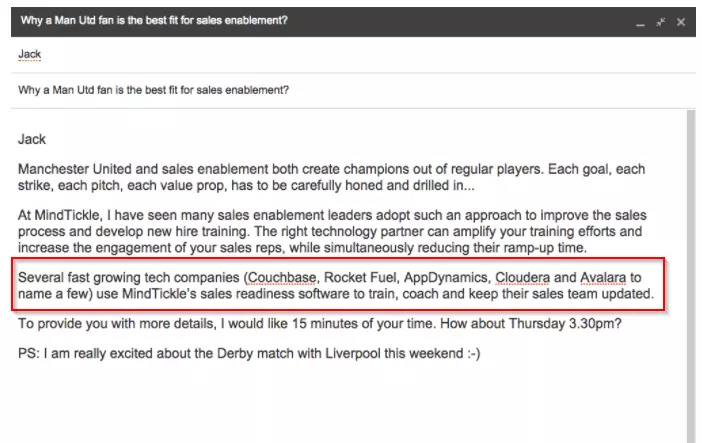
Since you're new to the prospect, therefore, try referring to something common and credible. It will improve reply rate.
Tell a story
Storytelling is one of the best approaches to making your cold email stand out from the crowd. It helps you connect with the reader by making your email closer to reality and easier to remember. Here is an example of how storytelling can be used in a cold email.

The story should be relevant to prospects' interest. This means you can use a single story for multiple prospects who have a common interest.
Keep it short
While you're busy telling a story, don't make your email too long. Cold emails should be kept short. Shane Snow sent 1000 cold emails including long as well as short emails to executives. Short emails had a 66.7% reply rate while long emails had 33.3% reply rate. Your email should be right on spot.
Use prospects personal email address
A personalized email should be sent to a personal email address. Period. Sending an email to info@domainname.com isn't a good idea and the email will most likely be ignored. When you send an email to prospect's personal email address, it is an indication that you have worked hard (finding the email address) and you're not just spamming. This is the best way to approach someone who doesn't know you.
Conclusion
Cold email is here to stay. You cannot go without it. So why not do it the right way? What's next? You have the ingredients and secret chef tips to create personalized emails, so let's get cracking.
About the author

Senko Duras - Passionate about digital marketing, entrepreneurship, growth, and travel, Senko is also a co-founder of Diversis Digital and Point Visible. Loves testing new ideas, projects with unclear specifications and fighting pressure with chill out attitude.